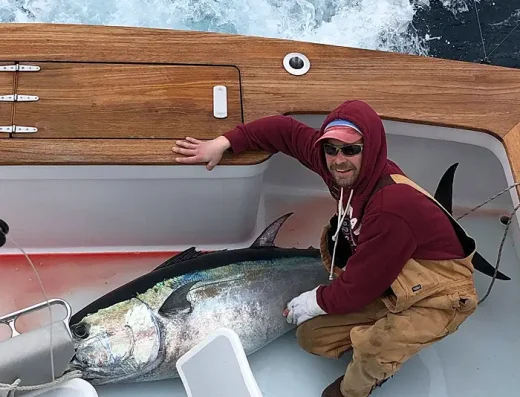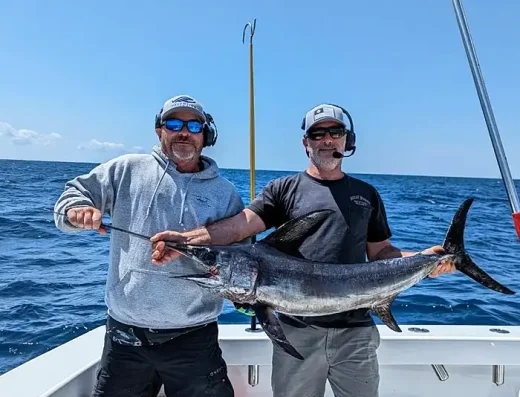Manteo Fishing Charters
Manteo fishing charters work the Roanoke Sound, Outer Banks surf, and nearshore Atlantic waters for red drum, speckled trout, cobia, tuna, and billfish.
Top Rated Charters in Manteo
TrustedFish connects anglers with proven local captains in Manteo. North Carolina —no commissions, no pay-to-play listings, no BS. Every charter on our platform is invite-only, vetted for skill, local knowledge, and reputation. If they’re listed, they’ve earned it.
Manteo, NC Fishing Guide
Manteo sits at the heart of the Outer Banks fishery, giving anglers access to both protected soundside waters and the open Atlantic. Most charters here run out of Shallowbag Bay and Pirate’s Cove Marina, with quick runs into the Roanoke and Croatan sounds for inshore trips or through Oregon Inlet for offshore runs. Half-day charters typically focus on light-tackle action in the sounds, chasing speckled trout, puppy drum, flounder, and bluefish along grass beds, oyster bars, and creek mouths. Full-day trips often push through the inlet to target nearshore Spanish mackerel, kingfish, cobia, and false albacore, while the big offshore runs put you on the Gulf Stream for yellowfin tuna, mahi, wahoo, and billfish.
The fishery around Manteo changes with the seasons. Spring brings strong runs of speckled trout and redfish in the sounds, while summer offshore action is at its peak for tuna and marlin. Fall delivers another push of inshore red drum and striped bass, while winter still sees steady speckled trout in the creeks and deep holes. The variety of habitats keeps fishing steady all year, with charters adapting tactics to match the conditions. Common methods include live bait rigs, trolling spreads offshore, popping corks in the shallows, vertical jigging around channels, and fly fishing for drum and albacore in the flats and rips.
Manteo’s location makes it a strong starting point for exploring nearby waters as well. The Roanoke Sound is right at the doorstep, while Croatan Sound and Albemarle Sound offer vast inshore grounds. Oregon Inlet is only a short run south, serving as the gateway to the deep Atlantic canyons. Whether you’re after a short inshore trip for steady action or a full Gulf Stream adventure, charters out of Manteo have it dialed in.
Fishing Seasons in Manteo
Spring (March–May)
Spring in Manteo means the sounds come alive with speckled trout and puppy drum. As water temps rise, these fish move shallow onto grass flats and creek mouths, feeding heavily on shrimp and baitfish. Light tackle and popping cork rigs with live shrimp or soft plastics are reliable, and fly anglers do well with small streamers. Nearshore trips start seeing Spanish mackerel and bluefish along the beaches by late April, while cobia begin to show near Oregon Inlet in May. Charters this time of year focus on half-day inshore trips, with some nearshore runs as conditions allow.
Summer (June–August)
Summer is peak offshore season for Manteo fishing charters. Boats running out of Oregon Inlet hit the Gulf Stream for yellowfin tuna, mahi, wahoo, and billfish, with blue marlin and white marlin at their best in July and August. Closer in, kingfish and cobia patrol wrecks and reefs, while Spanish mackerel school thick just off the beaches. Inshore, speckled trout and red drum remain steady targets in the sound, with topwater plugs working well at dawn and dusk. Summer heat pushes many anglers toward morning departures, but the action is steady across all waters.
Fall (September–November)
Fall fishing in Manteo is some of the best of the year. Big bull red drum show in the surf and inlets, giving anglers a shot at trophy-sized fish. Speckled trout bite hard in the creeks and grass edges, and striped bass start to return in cooler months, particularly around bridges and deeper channels. Offshore, tuna fishing heats back up, with yellowfin and blackfin tuna in solid numbers, joined by mahi and wahoo until water temperatures drop. Charters this season often split between inshore trophy drum hunts and offshore meat runs.
Winter (December–February)
Winter fishing in Manteo centers on the soundside creeks and deeper holes. Speckled trout remain the most consistent target, with fish stacking up in protected waters where slow jigging soft plastics works best. Striped bass are another key species, especially around bridge pilings and channels in the Albemarle and Croatan sounds. Offshore runs slow in winter due to weather, but hardy crews still make trips for bluefin tuna when they move through offshore waters near Oregon Inlet. Winter charters are typically shorter and more weather-dependent, but the fishing remains reliable for those who know the local waters.
Gamefish in Manteo
- Red Drum – Slot-sized fish year-round in the sounds, with trophy bulls in the fall surf and inlets on cut bait and jigs.
- Speckled Trout – Averaging 1–4 lbs, caught in the sounds and creeks on shrimp, soft plastics, and flies, strongest in spring and fall.
- Striped Bass – Caught fall through winter around bridges and channels, typically 5–15 lbs on jigging and trolling setups.
- Cobia – Summer visitor near Oregon Inlet, often sight-cast along buoys and nearshore rips with live eels or bucktails.
- Spanish Mackerel – Summer schools along the beaches, hit by trolling spoons and casting jigs to breaking fish.
- Yellowfin Tuna – Offshore Gulf Stream target spring through fall, with 20–60 lb fish common on trolling spreads.
- Mahi-Mahi – Summer offshore runs produce fish in the 10–30 lb class around weedlines and floating structure.
- Blue Marlin – Caught offshore in summer, mostly in July and August, on large trolling lures over deep structure.
Manteo Fishing FAQs
Where do most fishing charters in Manteo depart from?
Most trips leave out of Pirate’s Cove Marina or Shallowbag Bay, with quick access to Roanoke Sound and Oregon Inlet for offshore runs.
What trip lengths are available?
Half-day charters usually stay in the sounds for trout, drum, and flounder, while full-day trips run nearshore or offshore for bigger species like tuna and billfish.
What gear is provided by Manteo charters?
All rods, reels, tackle, and bait are provided. Many captains also clean and bag your catch at the dock.
Do I need a fishing license for a charter?
No, passengers are covered under the captain’s blanket license. If you fish on your own in local waters, you’ll need a North Carolina Coastal Recreational Fishing License.
When is the best time to fish in Manteo?
Spring and fall are best for inshore trout and drum, while summer offers the strongest offshore action for tuna and billfish. Winter still produces reliable speckled trout and striped bass in the creeks.
What fishing techniques are most common here?
Light tackle with popping corks and jigging rigs works well inshore, while offshore trips use trolling spreads and chunking for tuna. Fly fishing is also popular in the sounds for drum and albacore.
What species can kids and beginners target?
Bluefish, trout, and smaller drum in the sound make for easy action, while Spanish mackerel nearshore provide steady bites and short runs.
How big are the groups on most charters?
Inshore trips usually take 2–6 anglers on smaller skiffs, while offshore sportfishing boats carry groups of 6 for long-range Gulf Stream trips.
Are specialty trips like night fishing available?
Yes, some captains offer night fishing in the sounds, often for striped bass and speckled trout around bridges and lighted docks.


